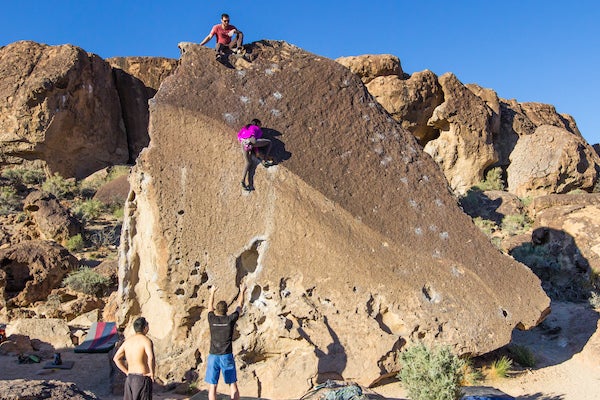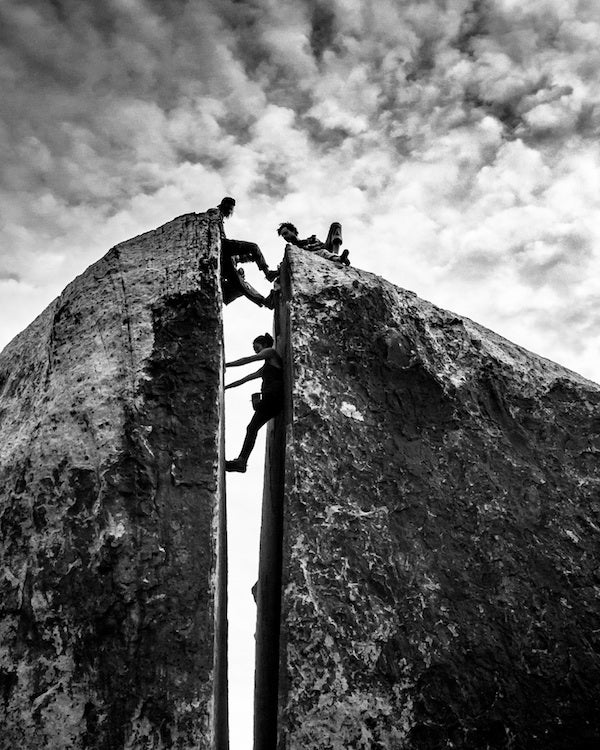This article was published in Scientific American’s former blog network and reflects the views of the author, not necessarily those of Scientific American
I occasionally find myself 20 feet off the ground, sweaty fingertips gripping granite crystals, one of my feet hovering hesitantly over a questionable knob of rock. A couple of foam pads and a motivating friend are beneath me. A clamor of supportive “You got this!” and “come on!” and “breathe!” builds as I stumble around the rock face.
Putting all my weight on the knob, committing, I stand up and reach for large rock flakes at the top of the boulder. A flood of emotions floating between elation and anxiety rolls in as I pull myself over the top.
“I never want to do that again!” I usually say after returning to the ground. Then, next time I’m outside, I’ll find myself inspired anew by tall boulders. I start to crave the experience of having to trust your feet, feel confident, breathe, and commit to the top.
On supporting science journalism
If you're enjoying this article, consider supporting our award-winning journalism by subscribing. By purchasing a subscription you are helping to ensure the future of impactful stories about the discoveries and ideas shaping our world today.
Danger, rush, craving. It’s these qualities that seem to drive the label of “adrenaline junkie.” But in my own adventures, what’s stuck with me more than the rush is the focus and calm I have to summon to commit to a spicy tall boulder. I had a feeling climbers’ incentives are more complex than adrenaline, so I asked science.

The classic climb “Heavenly Path” near Bishop, California requires delicate moves on scales of volcanic rock. Credit: Irene Jean
The most recent study on the topic of extreme sport motivation I found was by Robert Heirene at the University of South Wales. In his research, published in the Journal of Behavioral Addictions in June 2016, Heirene looked at withdrawal behaviors in climbers to understand whether climbing is addictive.
Heirene and his team tracked down eight climbers and asked them about how they felt when they abstained from climbing. The climbers drew from their experiences of injury and other circumstances where they couldn’t climb. Heirene looked for three qualities: anhedonia (where addiction leads to less interest in other activities), craving, and negative mood.
“I compare everything I do to climbing, and nothing compares,” one climber said during the interviews, a textbook example of anhedonia. All the climbers participated in few other hobbies, and suggested that climbing made other activities seem less exciting.
The climbers had cravings for the sport too. Some even made parallels to drugs:
“I would consider it very similar to having a cigarette in the morning or something like that,” one of the climbers said.
And all the climbers got stressed, frustrated, and restless when not climbing. Heirene said he was surprised by how rock climbers, no matter their ability, all reported strong cravings and negative emotions when they weren’t climbing.
I totally resonate with the climbers’ feelings; climbing is important to me, and not being able to do it is frustrating. But I feel somewhat cheated at same time by just focusing on craving and rush as reasons for climbing tall boulders.
.jpeg?w=600)
During hot southern California summers, climbers retreat to rocks in the mountains, such as this boulder in Holcomb Valley, San Bernardino National Forest. Credit: Patrick Gallagher
What sticks with me after a tall climb is not the adrenaline rush. Something about being high off the ground changes my perspective. My mind, normally darting between a hundred different thoughts, suddenly becomes solely focused on each individual feature in the rock, and each individual movement between them. It’s like extreme meditation.
So I kept searching for more answers.
Eric Brymer, psychology professor at Queensland University of Technology, is skeptical of comparing climbers to addicts. If you look hard enough for addictive behaviors using deductive methods like interviews, you’ll eventually find what you’re looking for, he said.
“A dog has four legs and a tail. That doesn’t mean that everything with four legs and a tail is a dog,” said Brymer.
Just because a climber’s statements match those of behavior addicts’ doesn’t mean that they neatly fit in with compulsive gamblers or shoppers. Cherry-picking qualities in addicts and looking for them in climbers doesn’t give us the full picture. Adrenaline happens, but it’s toward the end of the climb, said Brymer.
Brymer’s multiple interview-based studies of extreme sports athletes – big wave surfers, waterfall kayakers, and free solo (rope-less) climbers – has led him to a different perspective on the driving force of dangerous sports:
“It’s more of a freedom from cognitive thought, being able to surrender to the moment. Extreme sports athletes can’t be in control, but find out it’s okay. It’s very transformational,” said Brymer.
This seems more consistent with my own feelings on the wall. Climbing beyond my comfort zone is an intense feeling, but the fear factor is just one part of the multifaceted experience.
Heirene doesn’t deny the experience is complex, but maintains there are reasons to study the similarities between climbing and addiction. Since climbers and addicts have similar sensation-seeking traits, Heirene thinks taking up extreme sport could treat addiction by replacing a more harmful activity.
But Brymer points out that extreme sports require an exceptional amount of training and knowledge. Those with addiction can’t simply swap out a drug with a quick jump from a plane. They have to know how parachutes work, how the wind works.
Where we all come together is in agreeing that the motivations of so-called extreme athletes are complicated, but have clear benefits. Even in Heirene’s research, one climber commented:
“Climbing helps me get away from the negative things.”
And that’s the beauty of it. Beneath the glamorous façade of fearless adventurers seeking a thrill, climbing, and other adventurous or “extreme” activities can play a role in mental health. While sometimes the rush is fun, the takeaway is that “extreme” activities also enable people to simply function better.
I, too, need to get away from the negative things sometimes. And for me that means leaving the ground, and my troubles, behind, and climbing a rock.

Climbers in a split sandstone boulder at Red Rock Canyon National Conservation Area, Nevada. Credit: Will Bazargani